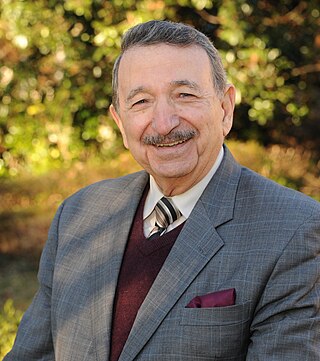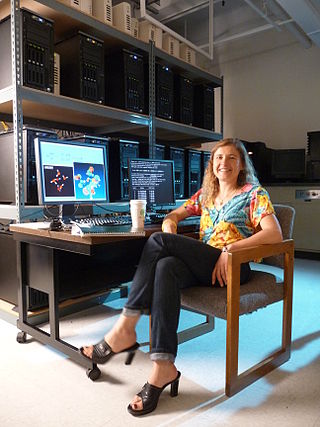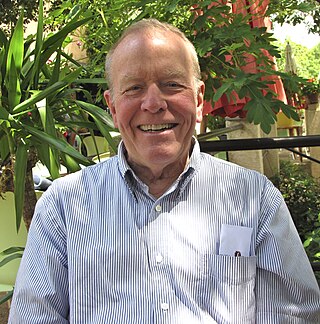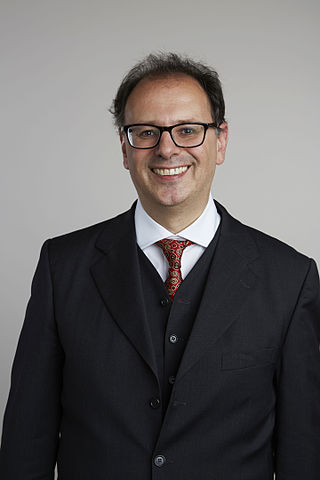
Computational chemistry is a branch of chemistry that uses computer simulation to assist in solving chemical problems. It uses methods of theoretical chemistry, incorporated into computer programs, to calculate the structures and properties of molecules, groups of molecules, and solids. The importance of this subject stems from the fact that, with the exception of some relatively recent findings related to the hydrogen molecular ion, achieving an accurate quantum mechanical depiction of chemical systems analytically, or in a closed form, is not feasible. The complexity inherent in many-body problem exacerbates the challenge of providing detailed descriptions in quantum mechanical systems. While computational results normally complement the information obtained by chemical experiments, it can in some cases predict unobserved chemical phenomena.

Armand Paul Alivisatos is an American chemist and academic administrator who has served as the 14th president of the University of Chicago since September 2021. He is a pioneer in nanomaterials development and an authority on the fabrication of nanocrystals and their use in biomedical and renewable energy applications. He was ranked fifth among the world's top 100 chemists for the period 2000–2010 in the list released by Thomson Reuters.

Mostafa A. El-Sayed is an Egyptian-American physical chemist, a leading nanoscience researcher, a member of the National Academy of Sciences and a US National Medal of Science laureate. He was the editor-in-chief of the Journal of Physical Chemistry during a critical period of growth. He is also known for the spectroscopy rule named after him, the El-Sayed rule.

Henry Frederick "Fritz" Schaefer III is a computational and theoretical chemist. He is one of the most highly cited chemists in the world, with a Thomson Reuters H-Index of 121 as of 2020. He is the Graham Perdue Professor of Chemistry and Director of the Center for Computational Chemistry at the University of Georgia. Before becoming professor at Georgia he was professor at University of California, Berkeley and in 2004, he became Professor of Chemistry Emeritus, at UC Berkeley

Martin Karplus is an Austrian and American theoretical chemist. He is the Director of the Biophysical Chemistry Laboratory, a joint laboratory between the French National Center for Scientific Research and the University of Strasbourg, France. He is also the Theodore William Richards Professor of Chemistry, emeritus at Harvard University. Karplus received the 2013 Nobel Prize in Chemistry, together with Michael Levitt and Arieh Warshel, for "the development of multiscale models for complex chemical systems".

Anna I. Krylov is the USC Associates Chair in Natural Sciences and Professor of Chemistry at the University of Southern California (USC), working in the field of theoretical and computational quantum chemistry. She is the inventor of the spin-flip method. Krylov is the president of Q-Chem, Inc. and an elected member of the International Academy of Quantum Molecular Science, the Academia Europaea, and the American Academy of Sciences and Letters.
Harden M. McConnell was an American physical chemist. His many awards included the National Medal of Science and the Wolf Prize, and he was elected to the National Academy of Science."
Dennis A. Dougherty is the George Grant Hoag Professor of Chemistry at California Institute of Technology. His research applies physical organic chemistry to systems of biological importance. Dougherty utilizes a variety of approaches to further our understanding of the human brain, including the in vivo nonsense suppression methodology for incorporating unnatural amino acids into a variety of ion channels for structure-function studies.
Andrew Streitwieser was an American chemist known for his contributions to physical organic chemistry.
Eric R. Bittner is a theoretical chemist, physicist, and distinguished professor of chemical physics at the University of Houston.

Donald Gene Truhlar is an American scientist working in theoretical and computational chemistry and chemical physics with special emphases on quantum mechanics and chemical dynamics.

William Lester Self Andrews is an American chemist who makes contributions to the ongoing development of quantum chemistry of metallic complexes. He is the Professor Emeritus of Chemistry at the University of Virginia. He won the Earle K. Plyler Prize for Molecular Spectroscopy in 2010 for "vibrational spectroscopy in cryogenic matrices that combined with quantum calculations, has led to the identification and characterization of many molecules, ions, and complexes across the periodic table".

James Bernhard Anderson was an American chemist and physicist. From 1995 to 2014 he was Evan Pugh Professor of Chemistry and Physics at the Pennsylvania State University. He specialized in Quantum Chemistry by Monte Carlo methods, molecular dynamics of reactive collisions, kinetics and mechanisms of gas phase reactions, and rare-event theory.

Judith P. Klinman is an American chemist, biochemist, and molecular biologist known for her work on enzyme catalysis. She became the first female professor in the physical sciences at the University of California, Berkeley in 1978, where she is now Professor of the Graduate School and Chancellor's Professor. In 2012, she was awarded the National Medal of Science by President Barack Obama. She is a member of the National Academy of Sciences, American Academy of Arts and Sciences, American Association for the Advancement of Science, and the American Philosophical Society.

Ali Alavi FRS is a professor of theoretical chemistry in the Department of Chemistry at the University of Cambridge and a Director of the Max Planck Institute for Solid State Research in Stuttgart.
Michael Roman Wasielewski is an American physical chemist. He is currently the Clare Hamilton Hall Professor of Chemistry, director of the Center for Molecular Quantum Transduction (CMQT), and Executive Director of the Institute for Sustainability and Energy at Northwestern University.
Moungi Bawendi is an American–Tunisian–French chemist. He is currently the Lester Wolfe Professor at the Massachusetts Institute of Technology. Bawendi is known for his advances in the chemical production of high-quality quantum dots. In 2023 he was awarded the Nobel Prize in Chemistry.
Cynthia J. Jameson is an Emeritus Professor of Chemistry at the University of Illinois. She works on nuclear magnetic resonance spectroscopy and quantum chemistry. Jameson dedicated her academic career to supporting women scientists. She is a Fellow of the American Association for the Advancement of Science.
The Percy L. Julian Award was first given in 1975 by the National Organization for the Professional Advancement of Black Chemists and Chemical Engineers (NOBCChE). The award is given every one to two years. It honors black scientists who have made significant contributions to the areas of pure or applied research in science or engineering.
Anne Bowen McCoy is a theoretical chemist. She is the Natt-Lingafelter Professor of Chemistry at the University of Washington, and her research interests include vibrational spectroscopy, hydrogen bonding, and charge-transfer bands. She received the 2023 Jack Simons Award in Theoretical Chemistry “for her development and application of theoretical methods for analyzing the vibrational spectra & dynamics of floppy molecules and clusters.”











